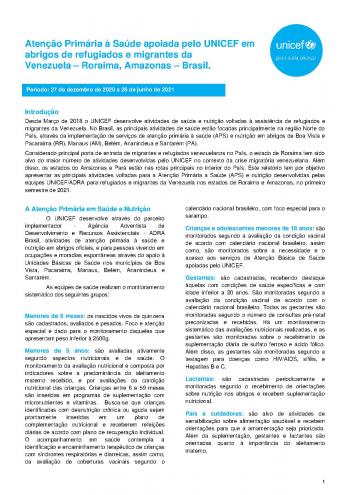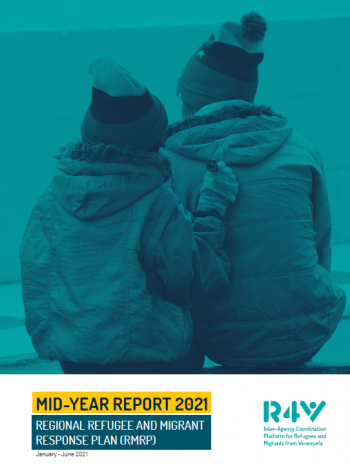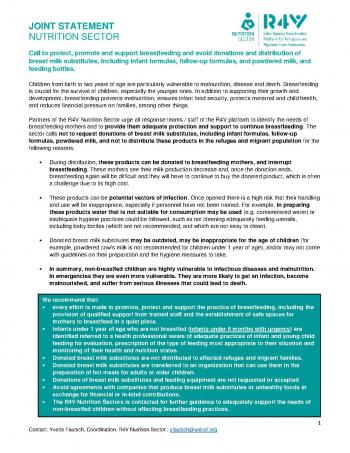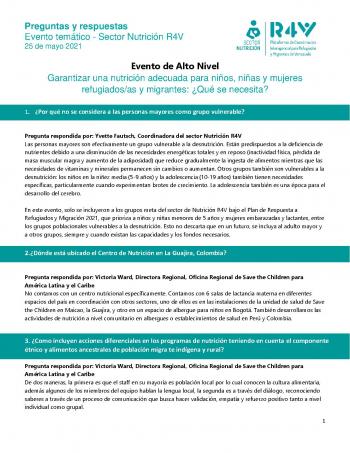Key Figures
What is the Nutrition Sector?
Priority Needs
The nutrition situation of refugee and migrant children remains an issue of concern, particularly acute malnutrition, as shown by nutritional screenings of refugee and migrant children under the age of five in 2019-2020 in Brazil, Ecuador, and Peru. This situation has been exacerbated by the COVID-19 crisis and will most likely continue in the years to come: an increase in malnutrition cases may be expected in 2021 as a result of the pandemic, mainly due to the deterioration of the level of food security among refugees and migrants and limited access to health and nutrition services.
Response Strategy
Scope of the sector response: Addressing the needs of the most nutritionally vulnerable, particularly children (under the age of five and under the age of two) and pregnant and lactating women will be at the core of the nutrition response in the region.
Response priorities: At regional level, the main response priorities are:
1. Provision of technical support and guidance to National and Sub-regional Platforms in the implementation, monitoring and reporting of response activities at the country level;
2. Capacity development of National and Subregional Platforms in key sectoral topics;
3. Facilitation of knowledge sharing and exchange of countries’ experiences, lessons learnt and best practices.
At the country level, main priorities are:
- Prevention of malnutrition in vulnerable groups, through infant and young child feeding counseling, targeting caregivers of children aged 6-23 months (focusing on appropriate breastfeeding and complementary feeding practices); micronutrient supplementation for children under the age of five, to fortify foods that are not sufficiently nutritionally diversified; and promotion of an adequate diet in pregnant and lactating women and provision of micronutrient supplementation (iron and folic acid).
- Identification and treatment of acute malnutrition, through screening refugee and migrant children under the age of five to monitor their nutritional status and identify cases of acute malnutrition, and refer identified cases to adequate treatment and follow-up until nutritional recovery.
Adapting activities to the COVID-19 context according to global guidelines will be key to avoid contamination risks.
Integrated response approaches
Coordination with the Health Sector will help to ensure access to essential nutrition services; coordination with the Food Security Sector will ensure that specific nutrition needs of vulnerable groups are taken into account in food assistance; and coordination with the WASH Sector will guarantee quality drinking water, basic sanitation and promote food hygiene practices.
Response modalities
The Nutrition Sector will mainly work through three modalities: 1) support to strengthen local nutrition services and capacities of community-based actors, health actors, R4V partners and local entities; 2) provision of supplies for the prevention and treatment of malnutrition (including micronutrient powders, micronutrient supplements, and ready-to-use therapeutic food); and 3) social and behavior change communication/awareness-raising to promote healthy dietary practices & diets, including feeding of children under the age of two, using local foods.
Event Calendar with filters
| Sun | Mon | Tue | Wed | Thu | Fri | Sat |
|---|---|---|---|---|---|---|
|
31
|
1
|
2
|
3
|
4
|
5
|
6
|
|
|
|
|
|
|
|
|
|
7
|
8
|
9
|
10
|
11
|
12
|
13
|
|
|
|
|
|
|
|
|
|
14
|
15
|
16
|
17
|
18
|
19
|
20
|
|
|
|
|
|
|
|
|
|
21
|
22
|
23
|
24
|
25
|
26
|
27
|
|
|
|
|
|
|
|
|
|
28
|
29
|
30
|
1
|
2
|
3
|
4
|
|
|
|
|
|
|
|
|





